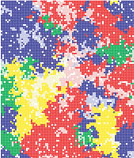Nature article: Beard Chromodynamics
 Here’s another peer-reviewed scientific article, published in Nature, that was probably published in the vicinity of April 1 due to its title:
Here’s another peer-reviewed scientific article, published in Nature, that was probably published in the vicinity of April 1 due to its title:
Vincent A. A. Jansen and Minus van Baalen (2006). “Altruism through beard chromodynamics.” Nature 440, 663-666 (30 March 2006).
Abstract: The evolution of altruism, a behaviour that benefits others at one’s own fitness expense, poses a darwinian paradox. The paradox is resolved if many interactions are with related individuals so that the benefits of altruism are reaped by copies of the altruistic gene in other individuals, a mechanism called kin selection. However, recognition of altruists could provide an alternative route towards the evolution of altruism. Arguably the simplest recognition system is a conspicuous, heritable tag, such as a green beard. Despite the fact that such genes have been reported, the ‘green beard effect’ has often been dismissed because it is unlikely that a single gene can code for altruism and a recognizable tag. Here we model the green beard effect and find that if recognition and altruism are always inherited together, the dynamics are highly unstable, leading to the loss of altruism. In contrast, if the effect is caused by loosely coupled separate genes, altruism is facilitated through beard chromodynamics in which many beard colours co-occur. This allows altruism to persist even in weakly structured populations and implies that the green beard effect, in the form of a fluid association of altruistic traits with a recognition tag, can be much more prevalent than hitherto assumed.
The phrase “green beard” was invented by Richard Dawkins as an example of an inherited visual display that would indicate that its possessor also possessed a genetic disposition for altruisum, and thus could be trusted. This sounds like it might be a way for genetic altruism to evolve, but if such a “tag” can evolve, then “fakers” might also easily evolve, making the tag pointless. This paper explores a situation, however, where beards (of multiple colors, hence “beard chromodynamics”) and altruism persist. From the conclusion:
Our results imply that the scope for green beard genes is much wider than often assumed. This is for a number of reasons. First, altruism can be maintained without all the functions for tag, recognition and altruism having to reside in a single locus: loose coupling between a recognition allele and altruistic trait suffices. Second, our results suggest that rather than there being a single green beard gene in a population, one can expect to find a diversity of such genes, especially if the population is weakly structured. A possible reason that so few coloured beards have been reported is the concentration of research on highly structured populations in which the diversity of beard colours is predicted to be low. Our analysis leads to the testable hypothesis that diversity in recognition tags inversely correlates with average relatedness. This suggests that relatively easily observed tag diversity can serve as an indicator for the nature of the underlying social interactions. Third, to detect the green beard effect one should look for cases where tag and trait can dynamically associate. A tag that functions as a green beard in one instance need not be associated with altruism in another population or at another instance in time, which obviously has consequences for our capacity to detect green beards.
